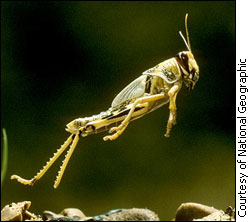
|
|
“The first second you feel the slightest amount of pain, you know exactly what's coming,” she says. “You know that in twenty minutes you're going to have no eyesight and not be able to move.”
Parsons is just one of many Canadians who suffer from migraines. Migraines are headaches so intense they can cause nausea, vomiting, vision loss, and sensitivity to light and sound. Parsons suffers from aural migraines, which means she experiences problems with her vision before the onset of a migraine. And like some other migraineurs, Parsons has yet to find relief from this debilitating condition. She is one of many whom Dr. Mel Robertson and his team at Queen's University hope to help. Robertson is studying the temperature point at which the breathing systems of locusts fail, and cause the insects to go into a coma. He noticed that just before failure, the systems of the locusts exhibit a phenomena which mimics cortical spreading depression, which is believed to cause human migraines. Cortical spreading depression is when part of the brain gets hyper-excited and then goes silent. This silence then spreads outwards, and is believed to be the precursor to migraine. Dr. Robertson hopes that by studying the systems of the locusts, we will be able to better understand what happens in the human brain during migraine, and hopefully develop new treatments for the many migraine sufferers. A new avenue for migraine research? During their research, the doctors observed that by exposing the locusts to higher temperatures before exposing them to temperatures which cause the locusts' systems to fail, they could raise the ultimate failure temperature — and the point at which the spreading depression phenomena occurs. When environmental conditions return to normal, the locusts recover. “The first part of the paper that was published establishes that we're looking at what I believe is exactly the same phenomena,” says Dr.Robertson, “and the second part says we can manipulate it.” Dr. Robertson and his colleagues observed that when the locusts' breathing systems failed, there was a surge of potassium ions outside the cell and a cessation in electrical activity. This surprised Robertson, who thought that his team would see a gradual growth in potassium. "It was that repetitive surging that made me think 'that looks like spreading depression'," says Robertson.
While developing a treatment from studying the systems of locusts may seem unlikely, Dr. Fred Freitag, associate director at the Diamond Headache Clinic in Chicago, says it is quite possible to use data collected from observing the system of one animal to better understand the conditions in another. Freitag says that there are also other migraine treatments being developed. These should be available to the general public within the next two to four years. One potential treament he finds particularly interesting is one where a spurt of carbon dioxide is pumped into the nose: “The sensation that one gets is equivalent to if you were drinking pop, and then laughed and then the pop went back up your nose.” Dr. Robertson says that the next steps in his research process involve identifying precisely which systems and pathways are being affected. Afterwards it will be up to the drug companies to try to develop a treatment from the research. Desperately seeking relief New treatments are always needed. While current treatments can bring relief to as many as 90 per cent of migraineurs, some people have trouble tolerating them. Parsons, whose migraines are triggered by hormones and changes in weather, says the medications prescribed to her caused strange symptoms, such as stiffness in the jaw. She has been to six doctors, none of whom have been able to help her. Although people are sympathetic, Parsons says they don't understand: “Unless you've ever had a migraine, you really don't know what it feels like.”
|
|
|
